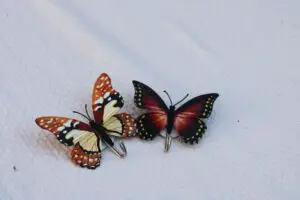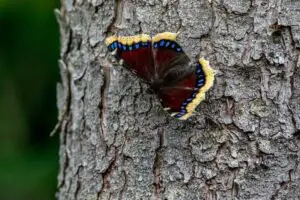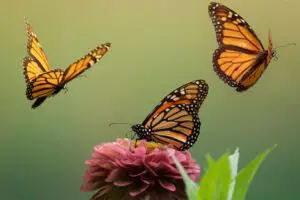Hello Everyone, Butterflies are one of the most beautiful creatures in nature. They are often seen fluttering from flower to flower or basking in the sun. Behind their delicate wings and graceful movements, lie an interesting set of facts about these fascinating insects. Facts of butterflies in this article, we will explore some remarkable things about butterflies that may surprise you. From what they eat, to where they live, there is much to learn about these lovely creatures.
1. How do butterflies use their wings colour?

Butterflies are beautiful insects known for their multi-colored wings. The facts about butterflies are that these colorful wings can serve many functions! One use of the butterfly’s vibrant pattern is to attract potential mates. The bright designs on their wings also help them blend into their environment and protect them from predators.
Furthermore, this coloration helps regulate the temperature of the butterfly’s body which can be important for long-distance migrations or extreme temperatures. Some academic studies have even revealed how different animals respond to specific colors in butterflies, such as how bees are attracted to yellow and pink patterns. Colorful wings are an essential part of butterflies’ survival strategy and one of the most fascinating aspects of these insects!
2. How many varieties of butterfiles spacies? and which?
Butterflies are one of the most diverse and colorful creatures in our ecosystem. While they may appear frail, these small animals have a variety of species that span across continents. Variety of Species of butterflies.
In total, there are over 20,000 known species of butterflies in the world. While most are found in tropical regions, some can be seen as far north as Greenland and Alaska. Butterflies live on every continent except Antarctica and their range extends from sea level to mountain tops at elevations up to 13,000 feet! Within each species, there can also be subspecies with variations in color or size depending on region or climate conditions.
Each butterfly species has its own unique characteristics from size to wing shape pattern to coloration, making it easy for scientists to distinguish them apart when conducting research studies or surveys.
3. Butterflies live a long time and their names
The life cycle of butterflies is one of the most fascinating biological processes in nature. But, did you know that not all butterfly species have the same life cycle? In fact, some species have a much longer life cycle than others.

The longest known life cycle for any butterfly species belongs to the Mourning Cloak Butterfly (Nymphalis antiopa). This beautiful creature can live up to 11 months as an adult and its larvae can overwinter in a dormant state for up to 9 months before pupating and emerging as an adult butterfly. This makes it one of the few insects that have a two-year life cycle! The Mourning Cloak Butterfly is also well-known for its migratory habits, which allow them to survive in cold climates where other butterflies cannot.
4. Fact about butterfly egg
Butterflies are some of the most beautiful and fascinating creatures in nature. While they may seem delicate, there is more to these colorful insects than meets the eye. From their egg-laying habits to their life cycles, here are five interesting facts about butterfly eggs that you may not have known!
- The first fact is that female butterflies lay their eggs in batches or clusters.
- This helps protect the eggs from predators such as ants and birds.
- Additionally, some species of butterflies will lay their eggs on specific plants or flowers in order to ensure optimal nutrition for when their young hatch.
- Another interesting fact about butterfly egg-laying habits is that the female will often lay her eggs close together so that when they hatch, the larvae can feed off each other’s waste products for extra nourishment.
Read more about the Butterfly life cycle
5. How many eggs do butterflies lay at a time
The amazing butterfly has many interesting facts associated with it, such as the incredible amount of eggs they lay. Butterflies are known to lay anywhere from one egg all the way to several hundred. But just how many eggs do butterflies lay at a time? To answer this question we must look at different species and their reproduction habits.
Female butterflies typically will lay individual eggs on the underside of leaves or stems, depending on the type of host plant they need for survival. Swallowtail butterflies are known to produce larger amounts than most other species, laying between 20 and 200 eggs in clusters during mating season.

Monarch butterflies also produce large numbers of eggs—up to 600 per female—but they will usually only lay a few at a time over several days or weeks in order to ensure that their young get enough food
6. The pollination potential of flowers is more important to ecosystems than you might think
The ecosystem of butterflies is a fascinating and complex one. As the most colorful of all insects, butterflies are often considered one of nature’s most beautiful creatures. But there’s much more to these winged wonders than their delicate beauty—they also play an important role in global ecosystems. Here are five facts about this remarkable species that help to explain they’re vital importance:
First, butterflies feed on nectar from flowers, helping to pollinate them so they can reproduce and thrive. They also provide food for birds, lizards, amphibians, and other animals with their larvae. Furthermore, they act as natural pest controllers by consuming aphids and other plant-eating pests alike.

Second, butterflies themselves have numerous predators throughout their lives such as frogs that eat adult butterflies or spiders that feast on butterfly eggs or caterpillars.
7. Butterflies live on an all-liquid diet
Butterflies are a species of insects known for their vibrant colors and graceful flight patterns. Despite their delicate appearance, these creatures lead surprisingly hardy lives–in part due to the fact that they live on an all-liquid diet. Facts of butterflies will help to educate readers on five more facts about butterflies, with a particular focus on their liquid diets.
Just like humans and other animals, butterflies require nourishment in order to survive. However, unlike humans and other animals, butterflies can only consume liquids. Their primary food source is nectar from flowers; however, they also occasionally consume water or fruit juices for added nutrients. During times of drought or cold temperatures when flowers are not in bloom, certain species of butterflies rely heavily on sap from trees as an alternative food source. Additionally, some species may drink from puddles or mud if desperate enough for sustenance.
8. Some adult butterflies live only 1-2 weeks
When we think of butterflies, they often bring to mind their beauty and grace. But there is so much more to these elegant creatures than meets the eye. Did you know that some adult butterfly species live only 1-2 weeks? It’s true! Here are five interesting facts about butterflies that will surprise and delight you.
First, some butterfly species live up to a year or longer, while other species have a very short lifespan of just 1-2 weeks. This is because many butterfly species feed on the nectar from flowers for fuel and must constantly be able to find new sources of food in order to survive. Additionally, due to environmental factors such as weather changes and predators, the lifespan of a butterfly can be drastically shortened.
Butterflies also experience an incredible transformation from caterpillars into beautiful adults with wings.
You May also like this!
Conclusion
The conclusion to the article ” facts of butterflies” is that these beautiful creatures are a testament to nature’s beauty and diversity. Butterflies are incredibly important to ecosystems and the environment as a whole, providing pollination services for many other species and performing crucial roles in the food chain. As butterfly populations continue to decline due to human activities such as deforestation, it is important for us all to take action in order to help protect these colorful insects from further harm.
We can encourage sustainability efforts in our own lives, including reducing our carbon footprints, planting native plants that attract local butterflies, and not using pesticides that can contaminate their habitats. By taking action now, we can ensure that future generations will be able to enjoy the sight of these delicate creatures fluttering through our gardens and parks.
